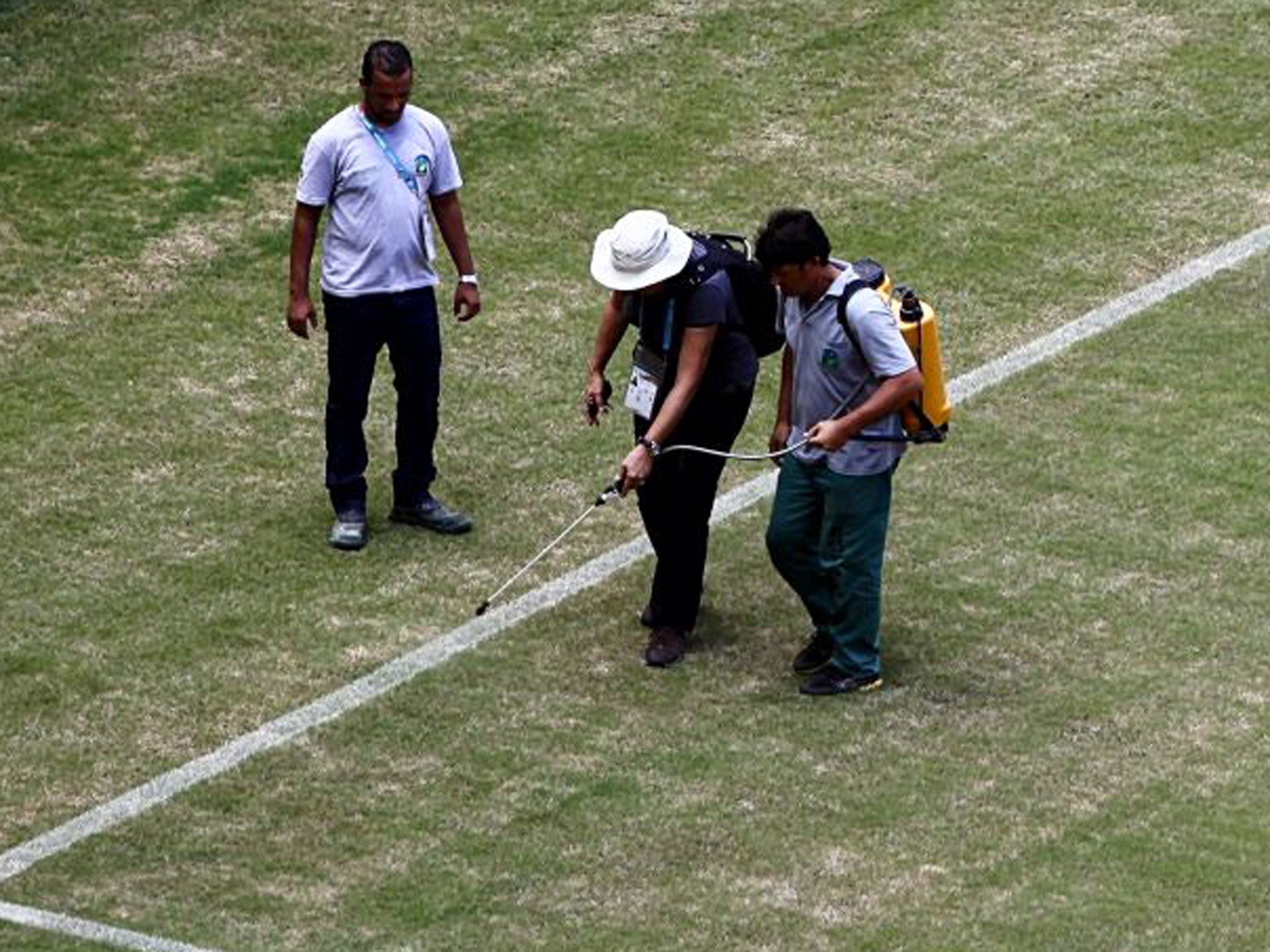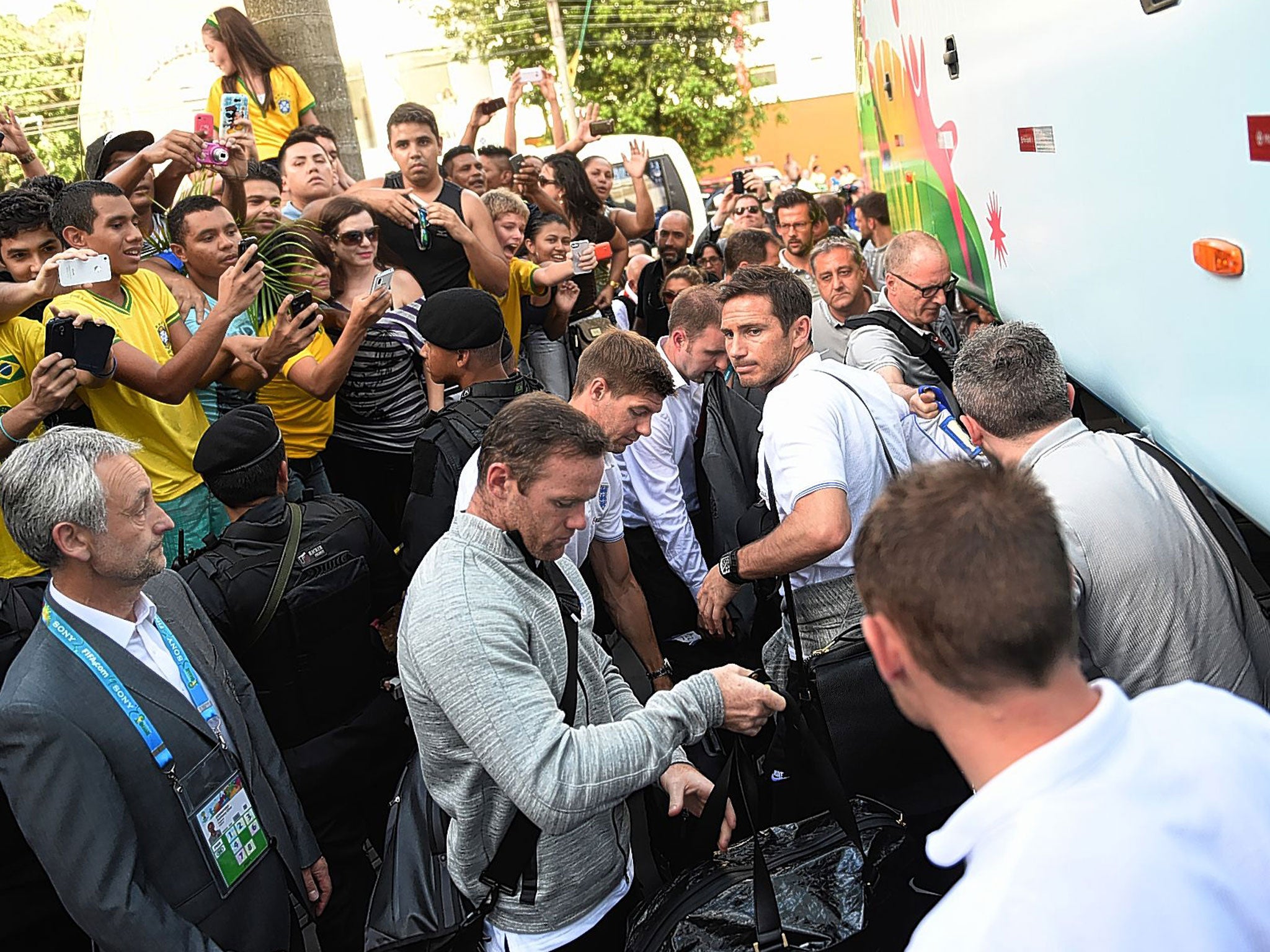England v Italy: Are they painting the Manaus pitch green?
Threadbare pitch still off limits as workers apply final touches at stadium

The Manaus stadium that will host England’s World Cup opener against Italy on Saturday was in a race against time on Thursday to be ready for kick-off, with the pitch still brown, dry and sandy in places and much of the interior areas, even those around the changing rooms, still frantically being cleaned with 48 hours to go.
England will train here on Friday at 5.15pm local time, having elected to work in the gym at their hotel on Thursday rather than use their Fifa designated training ground. At mid-afternoon one of the ground staff at the Arena Amazonia could clearly be seen with a yellow canister on his back spraying the brown areas of the pitch under the direction of an official. He concentrated on the penalty areas, which are particularly brown and dusty-looking.
The Fifa delegate present on that occasion could not say whether it was paint, fertiliser or something else that was being sprayed on to the pitch.
In some areas of the stadium, there were workers with dust-masks on their faces clearing up the site in preparation for what will be the first major sporting event it has hosted. There were building workers all over the site and reporters were told they could not go to pitch-side because cabling was still being laid for match-day photographers. There is still rubbish strewn in some external areas.
The changing rooms – England are in the “A” dressing room – looked impressive and complete, albeit in need of a thorough clean. The medical centre is complete and fully staffed. Fifa officials agreed to a tour of the stadium but drew the line at allowing photographers and reporters down to pitch-side.
In a statement, Fifa said: “The pitch in Manaus has been undergoing treatment in preparation for the World Cup. Over the last three months, mitigation procedures have been put in place and there continues to be significant improvement.
“Pitch experts from Fifa and the local organising committee are satisfied that the pitch will be ready for training and the matches, and have been based in Manaus to ensure that all proper procedures are in place.”
Arriving at the stadium on Thursday afternoon, I encountered a group of workmen busying themselves with the stadium car park. The tarmac was still spongy but they were pressing ahead with painting the lines in yellow paint nonetheless, and cheerily pointed to the corner where I could get out and back to the road.

The stadium is not yet finished. It may never be finished, according to the official, European-approved standard. But the people here believe they are ready. England’s first game in a city in the Amazon rainforest on Saturday is an event that Manaus has been waiting for in eager anticipation ever since it was given host city status and it is not about to allow what it regards as minor considerations over the quality of the pitch or the climate to get in the way of its big day.
To put into perspective the location of Manaus, and what it represents for this part of Brazil, it is worth revisiting a few simple facts about the Amazon, culled from Brazil on the Rise, an excellent book on the country’s development by the American journalist Larry Rohter, who was the New York Times correspondent here for eight years.
The Amazon encompasses 60 per cent of Brazil’s territory, but has just 10 per cent of its population. The rainforest itself covers an area bigger than Europe. It was opened to large-scale development less than 50 years ago and since then, Rohter writes, 20 per cent of it has been “burned, cut, chopped or razed”. Yet there are still no roads to Manaus, the biggest city in the Amazon. You have to fly in, as the England team did from their base in Rio de Janeiro.
It felt remarkable that, with England finally in the city they have been preparing to play in since the draw, they did not venture outside their hotel for a training session. The official Football Association position was that this was in keeping with previous preparations on “MD-2” (clunky Fifa-speak for two days before a game). But they will train at the stadium later today.
The remarks by Roy Hodgson about Manaus, made before the draw in Salvador in December, still cut deep here. The England manager infamously said that it was “the one to avoid”, a comment he is still trying to live down. Leaving aside the grandstanding by local politicians on the issue, there was a genuine concern that Manaus’s chance to show itself off to the world – as a travellers’ hub for exploring the greatest biodiversity anywhere on earth – would be lost.
The city hosts four group games, but none bigger than England against Italy. As a consequence it launched its own PR campaign, including a television advert presented by two Manaus residents, one from England and the other from Italy, discussing why they loved the city. Manaus has a 19th-century opera house, the Teatro Amazonas, brought over by boat during the days of the rubber barons. The venue then had a rubberised drive so late arrivals would not disturb performances.
The attention to detail has not been quite so fastidious for the stadium itself. Organisers have run out of time to make the finishing touches. In the wider area around the stadium there was still work going on and to one side great mounds of earth that have been deposited, behind a nearby gymnasium. From the inside, however, and for the purposes of television, the stadium will look the part.
Join our commenting forum
Join thought-provoking conversations, follow other Independent readers and see their replies
0Comments